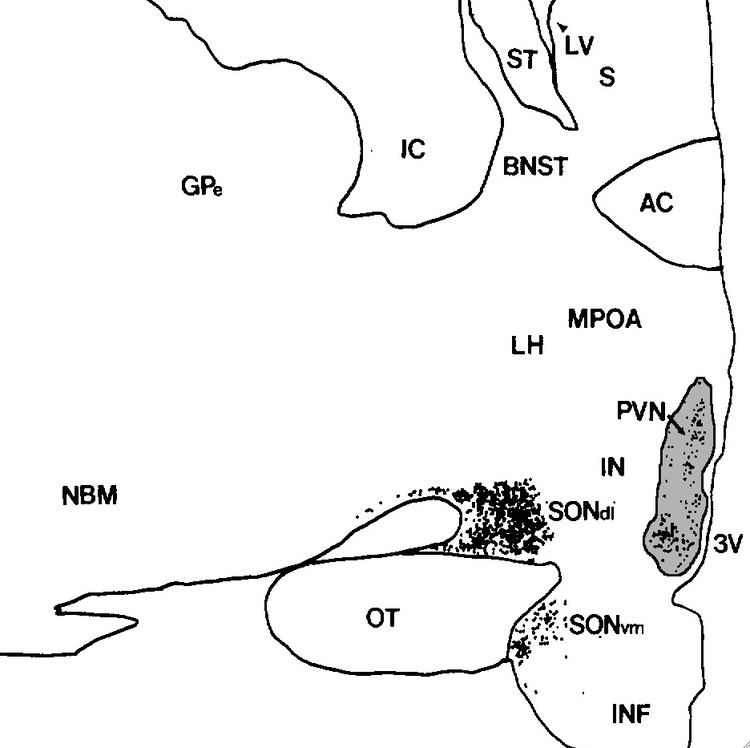NeuroNames hier-370 TA A14.1.08.909 | Dorlands/Elsevier n_11/12582324 | |
 | ||
Latin Nucleus paraventricularis hypothalami MeSH A08.186.211.730.385.357.342.400 NeuroLex ID Paraventricular nucleus of hypothalamus | ||
The paraventricular nucleus (PVN, PVA, or PVH) is a neuronal nucleus in the hypothalamus. It contains groups of neurons that can be activated by stressful and/or physiological changes. Many PVN neurons project directly to the posterior pituitary where they release oxytocin or vasopressin into the general circulation. Other PVN neurons control various anterior pituitary functions, while still others directly regulate appetite and autonomic functions in the brainstem and spinal cord.
Contents
Location
The paraventricular nucleus lies adjacent to the third ventricle. It lies within the periventricular zone and is not to be confused with the periventricular nucleus, which occupies a more medial position, beneath the third ventricle. The PVN is highly vascularised and is protected by the blood–brain barrier, although its neuroendocrine neurons extend to sites (in the median eminence and in the posterior pituitary) beyond the blood–brain barrier.
Neurons
The PVN contains magnocellular neurosecretory cells whose axons extend into the posterior pituitary, parvocellular neurosecretory (neuroendocrine) cells that project to the median eminence, and several populations of peptide-containing cells that project to many different brain regions including parvocellular preautonomic cells that project to the brainstem and spinal cord.
Magnocellular neurosecretory neurons
The magnocellular cells in the PVN elaborate and secrete two peptide hormones: oxytocin and vasopressin.
These hormones are packaged into large vesicles, which are then transported down the unmyelinated axons of the cells and released from neurosecretory nerve terminals residing in the posterior pituitary gland.
Similar magnocellular neurons are found in the supraoptic nucleus. They also secrete vasopressin.
Parvocellular neurosecretory (Neuroendocrine) neurons
The axons of the parvocellular neurosecretory neurons of the PVN project to the median eminence, a neurohemal organ at the base of the brain, where their neurosecretory nerve terminals release their hormones at the primary capillary plexus of the hypophyseal portal system. The median eminence contains fiber terminals from many hypothalamic neuroendocrine neurons, secreting different neurotransmitters or neuropeptides, including vasopressin, corticotropin-releasing hormone (CRH), thyrotropin-releasing hormone (TRH), gonadotropin-releasing hormone (GnRH), growth hormone-releasing hormone (GHRH), dopamine (DA) and somatostatin (growth hormone release inhibiting hormone, GIH) into blood vessels in the hypophyseal portal system. The blood vessels carry the peptides to the anterior pituitary gland, where they regulate the secretion of hormones into the systemic circulation. The parvocellular neurosecretory cells include those that make:
Centrally-projecting (Preautonomic) neurons
As well as neuroendocrine neurons, the PVN contains interneurons and populations of neurons that project centrally (i.e., to other brain regions). The centrally-projecting neurons include
Afferent inputs to the PVN
The PVN receives afferent inputs from many brain regions and different parts of the body, by hormonal control.
Among these, inputs from neurons in structures adjacent to the anterior wall of the third ventricle (the "AV3V region") carry information about the electrolyte composition of the blood, and about circulating concentrations of such hormones as angiotensin and relaxin, to regulate the magnocellular neurons.
Inputs from the brainstem (the nucleus of the solitary tract) and the ventrolateral medulla carry information from the heart and stomach. Inputs from the hippocampus to the CRH neurones are important regulators of stress responses.
Inputs from neuropeptide Y-containing neurons in the arcuate nucleus coordinate metabolic regulation (via TRH secretion) with regulation of energy intake.
Inputs from suprachiasmatic nucleus about levels of lighting (circadian rhythms).
Inputs from glucose sensors within the brain stimulate release of vasopressin and Corticotropin-releasing hormone from Parvocellular neurosecretory cells .
